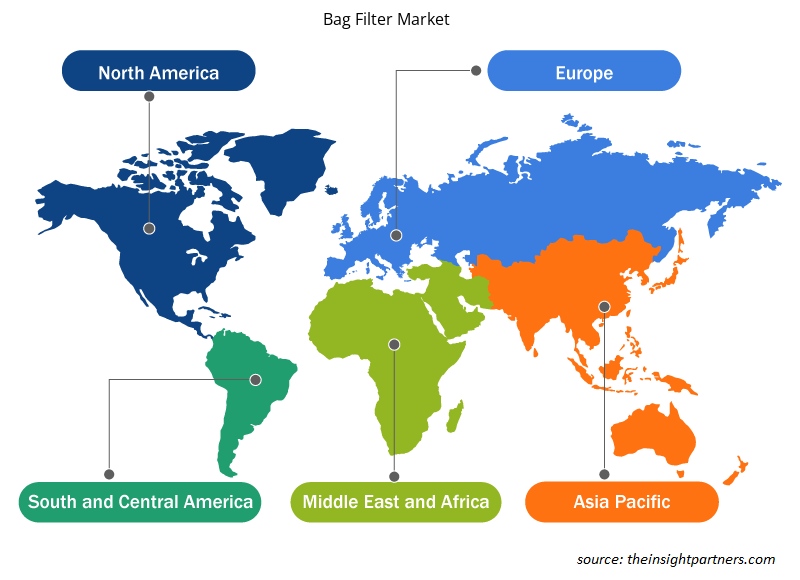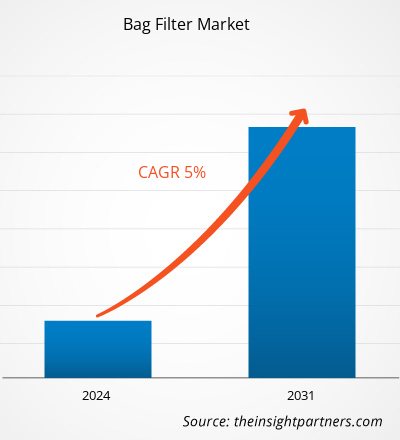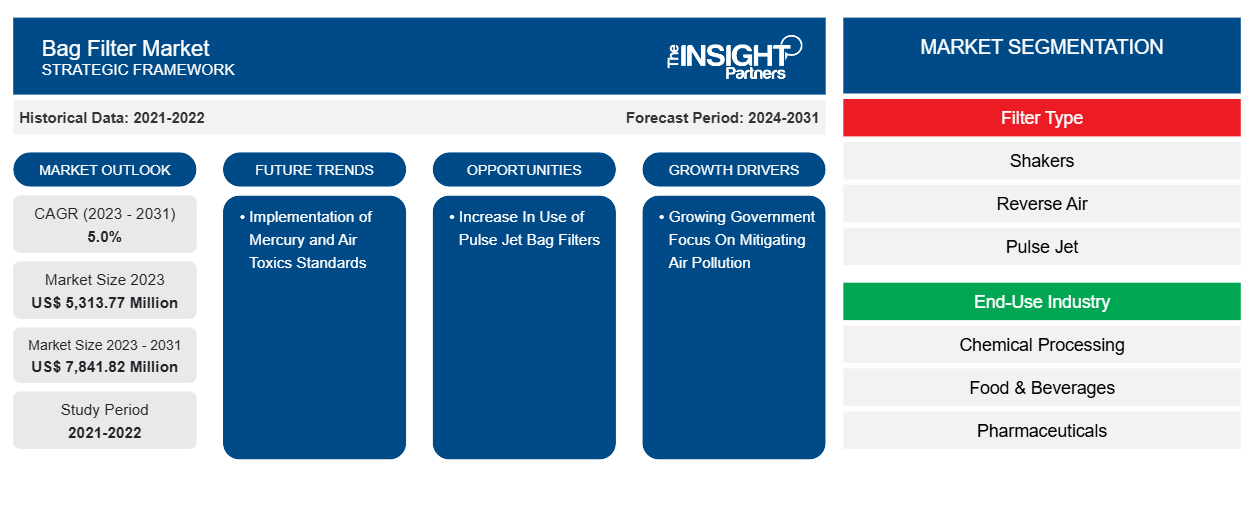Se proyecta que el tamaño del mercado de filtros de mangas alcance los 7.841,82 millones de dólares estadounidenses en 2031, frente a los 5.313,77 millones de dólares estadounidenses en 2023. Se espera que el mercado registre una CAGR del 5,0 % durante el período 2023-2031. Es probable que la aplicación de normas sobre mercurio y tóxicos del aire siga siendo una tendencia clave en el mercado.
Análisis del mercado de filtros de mangas
Las carcasas de los filtros de mangas que se utilizan en las industrias minera y química suelen tener un sello ASME y deben estar hechas de acero inoxidable. El proceso de filtración normalmente debe cumplir con requisitos estrictos y, con frecuencia, debe poder filtrar partículas más pequeñas que una micra. Los filtros de mangas funcionales suelen tener una eficiencia de recolección de partículas del 99 % o más, independientemente de los tamaños de partículas extremadamente pequeños, a diferencia de los precipitadores electrostáticos, cuyo rendimiento puede variar en gran medida según el proceso y las condiciones eléctricas. Algunos filtros de mangas vienen equipados con bocinas ultrasónicas que producen vibraciones adicionales para mejorar la eliminación del polvo. Las bocinas se activan poco antes o al comienzo del ciclo de limpieza para ayudar a romper las uniones entre las partículas en la superficie del medio filtrante. Se han implementado varias restricciones nuevas en los países desarrollados de América del Norte y Europa Occidental para frenar las emisiones industriales nocivas. Los cambios frecuentes en las leyes exigen una modernización o actualización frecuente de los sistemas de filtros de mangas en las plantas industriales.
Descripción general del mercado de filtros de mangas
Existen varias configuraciones de filtros de bolsa disponibles en el mercado, diseñados exclusivamente para satisfacer las necesidades operativas. Desde filtros de bolsa estándar hasta productos diseñados a medida, los fabricantes ofrecen distintos tipos de productos a sus clientes. Debido a su bajo costo y alto nivel de confiabilidad, los filtros de bolsa industriales se utilizan con frecuencia en la industria de alimentos y bebidas. Los filtros de bolsa o de ósmosis inversa con carbón activado se utilizan ampliamente para purificar el agua de impurezas.
Personalice este informe según sus necesidades
Obtendrá personalización en cualquier informe, sin cargo, incluidas partes de este informe o análisis a nivel de país, paquete de datos de Excel, así como también grandes ofertas y descuentos para empresas emergentes y universidades.
-
Obtenga las principales tendencias clave del mercado de este informe.Esta muestra GRATUITA incluirá análisis de datos, desde tendencias del mercado hasta estimaciones y pronósticos.
Factores impulsores y oportunidades del mercado de filtros de mangas
El creciente interés del gobierno por mitigar la contaminación del aire favorece al mercado
Con el objetivo de reducir el impacto de las emisiones industriales y disminuir el nivel de emisiones del sector industrial, los gobiernos de varios países están estableciendo leyes y regulaciones para mitigar la contaminación del aire. Se prevé que el creciente desarrollo y expansión del sector industrial junto con la creciente urbanización aumenten el nivel de contaminación del aire, lo que afecta directamente la salud y aumenta el número de enfermedades transmitidas por el aire. Por lo tanto, el creciente enfoque gubernamental en la reducción de los niveles de contaminación del aire está dirigiendo el enfoque gubernamental hacia la implementación de políticas estrictas en el sector industrial, lo que está impulsando la demanda de filtros de bolsa a nivel mundial.
Aumento del uso de filtros de mangas Pulse Jet
Para satisfacer las necesidades de seguridad de la calidad del aire en el lugar de trabajo, los filtros de mangas de chorro de pulso son uno de los equipos de control de la contaminación del aire más populares . Los colectores de polvo de chorro de pulso están diseñados principalmente para capturar y reducir eficazmente las partículas y emisiones potencialmente tóxicas. La eficiencia de los filtros de chorro de pulso está impulsando su aplicación a nivel mundial.
Análisis de segmentación del informe de mercado de filtros de bolsa
Los segmentos clave que contribuyeron a la derivación del análisis del mercado de filtros de bolsas son el tipo de filtro y la industria de uso final.
- Según el tipo de filtro, el mercado de filtros de mangas se divide en filtros agitadores, filtros de aire inverso y filtros de chorro pulsado. El segmento de filtros de chorro pulsado tuvo una mayor participación de mercado en 2023.
- Por industria de uso final, el mercado está segmentado en procesamiento químico, alimentos y bebidas, productos farmacéuticos, papel y pulpa, tratamiento de agua y otros. El segmento de procesamiento químico tuvo una participación significativa del mercado en 2023.
Análisis de la cuota de mercado de los filtros de mangas por geografía
El alcance geográfico del informe de mercado de filtros de bolsas se divide principalmente en cinco regiones: América del Norte, Asia Pacífico, Europa, Medio Oriente y África, y América del Sur y Central.
América del Norte lidera el mercado. Estados Unidos lidera el mercado de filtros de mangas en América del Norte. El creciente desarrollo del sector industrial y el creciente interés del gobierno por mitigar el nivel de contaminación del aire del sector industrial están impulsando el crecimiento del mercado de filtros de mangas en América del Norte. Países como el Reino Unido, Francia, Alemania y Bélgica son los pocos países con un mayor número de industrias químicas y de alimentos y bebidas, lo que está impulsando el crecimiento en toda Europa. El creciente número de instalaciones de tratamiento de agua y aguas residuales en Asia Pacífico está teniendo un impacto positivo en el mercado de filtros de mangas en Asia Pacífico.
Perspectivas regionales del mercado de filtros de mangas
Los analistas de Insight Partners explicaron en detalle las tendencias y los factores regionales que influyen en el mercado de filtros de mangas durante el período de pronóstico. Esta sección también analiza los segmentos y la geografía del mercado de filtros de mangas en América del Norte, Europa, Asia Pacífico, Oriente Medio y África, y América del Sur y Central.

- Obtenga datos regionales específicos para el mercado de filtros de mangas
Alcance del informe de mercado de filtros de mangas
| Atributo del informe | Detalles |
|---|---|
| Tamaño del mercado en 2023 | US$ 5.313,77 millones |
| Tamaño del mercado en 2031 | US$ 7.841,82 millones |
| CAGR global (2023 - 2031) | 5.0% |
| Datos históricos | 2021-2022 |
| Período de pronóstico | 2024-2031 |
| Segmentos cubiertos |
Por tipo de filtro
|
| Regiones y países cubiertos |
América del norte
|
| Líderes del mercado y perfiles de empresas clave |
|
Densidad de actores del mercado: comprensión de su impacto en la dinámica empresarial
El mercado de filtros de mangas está creciendo rápidamente, impulsado por la creciente demanda de los usuarios finales debido a factores como la evolución de las preferencias de los consumidores, los avances tecnológicos y una mayor conciencia de los beneficios del producto. A medida que aumenta la demanda, las empresas amplían sus ofertas, innovan para satisfacer las necesidades de los consumidores y aprovechan las tendencias emergentes, lo que impulsa aún más el crecimiento del mercado.
La densidad de actores del mercado se refiere a la distribución de las empresas o firmas que operan dentro de un mercado o industria en particular. Indica cuántos competidores (actores del mercado) están presentes en un espacio de mercado determinado en relación con su tamaño o valor total de mercado.
Las principales empresas que operan en el mercado de filtros de bolsas son:
- Empresas Babcock & Wilcox Inc.
- Empresa de transporte y almacenamiento BWF Offermann, Waldenfels & Co. KG
- Camfil
- Corporación Danaher
- Compañía Donaldson, Inc.
- Corporación Eaton plc
Descargo de responsabilidad : Las empresas enumeradas anteriormente no están clasificadas en ningún orden particular.

- Obtenga una descripción general de los principales actores clave del mercado de filtros de bolsas
Noticias y desarrollos recientes del mercado de filtros de mangas
El mercado de filtros de mangas se evalúa mediante la recopilación de datos cualitativos y cuantitativos a partir de una investigación primaria y secundaria, que incluye publicaciones corporativas importantes, datos de asociaciones y bases de datos. A continuación, se enumeran algunos de los avances en el mercado de filtros de mangas:
- Parker Hannifin Corp. ha lanzado un filtro de mangas plisadas para su uso en aplicaciones de calor extremo. (Fuente: Parker Hannifin Corp, comunicado de prensa, mayo de 2022)
- Babcock & Wilcox adquiere FPS. Babcock and Wilcox Enterprises, Inc. anunció la adquisición de Fossil Power Systems, Inc., un reconocido productor de gas natural, hidrógeno y equipos de combustión de pulpa y papel renovables. (Fuente: Babcock & Wilcox, comunicado de prensa, febrero de 2022)
Informe de mercado sobre filtros de mangas: cobertura y resultados
El informe “Tamaño y pronóstico del mercado de filtros de bolsas (2021-2031)” proporciona un análisis detallado del mercado que cubre las siguientes áreas:
- Tamaño del mercado de filtros de bolsas y pronóstico a nivel global, regional y nacional para todos los segmentos clave del mercado cubiertos bajo el alcance
- Tendencias del mercado de filtros de mangas, así como dinámica del mercado, como impulsores, restricciones y oportunidades clave
- Análisis PEST y FODA detallados
- Análisis del mercado de filtros de mangas que cubre las tendencias clave del mercado, el marco global y regional, los principales actores, las regulaciones y los desarrollos recientes del mercado
- Análisis del panorama de la industria y de la competencia que abarca la concentración del mercado, el análisis de mapas de calor, los actores destacados y los desarrollos recientes del mercado de filtros de mangas
- Perfiles detallados de empresas
- Análisis histórico (2 años), año base, pronóstico (7 años) con CAGR
- Análisis PEST y FODA
- Tamaño del mercado, valor/volumen: global, regional y nacional
- Industria y panorama competitivo
- Conjunto de datos de Excel
Informes recientes
Testimonios
Razón para comprar
- Toma de decisiones informada
- Comprensión de la dinámica del mercado
- Análisis competitivo
- Información sobre clientes
- Pronósticos del mercado
- Mitigación de riesgos
- Planificación estratégica
- Justificación de la inversión
- Identificación de mercados emergentes
- Mejora de las estrategias de marketing
- Impulso de la eficiencia operativa
- Alineación con las tendencias regulatorias























 Obtenga una muestra gratuita para - Mercado de filtros de bolsas
Obtenga una muestra gratuita para - Mercado de filtros de bolsas